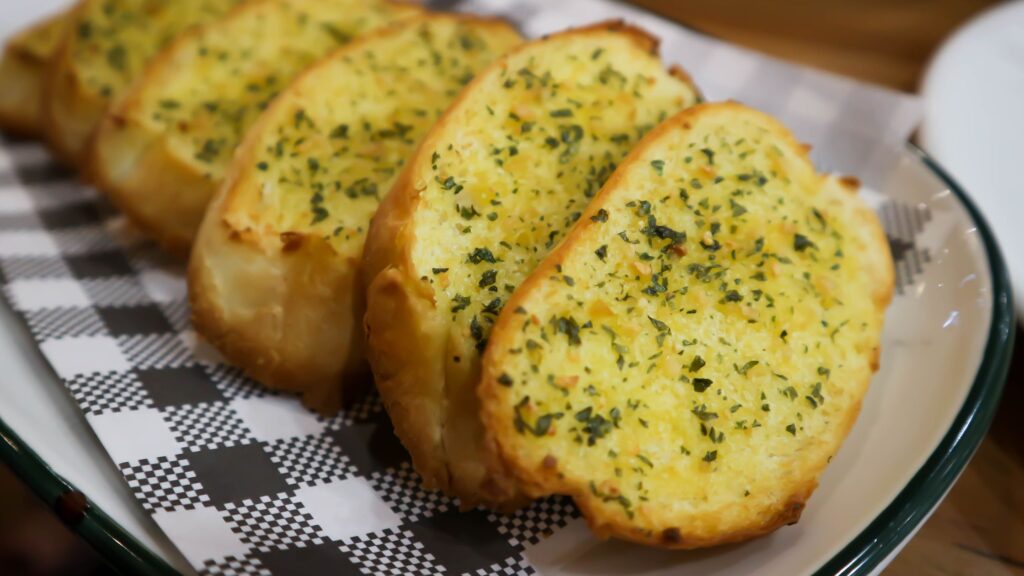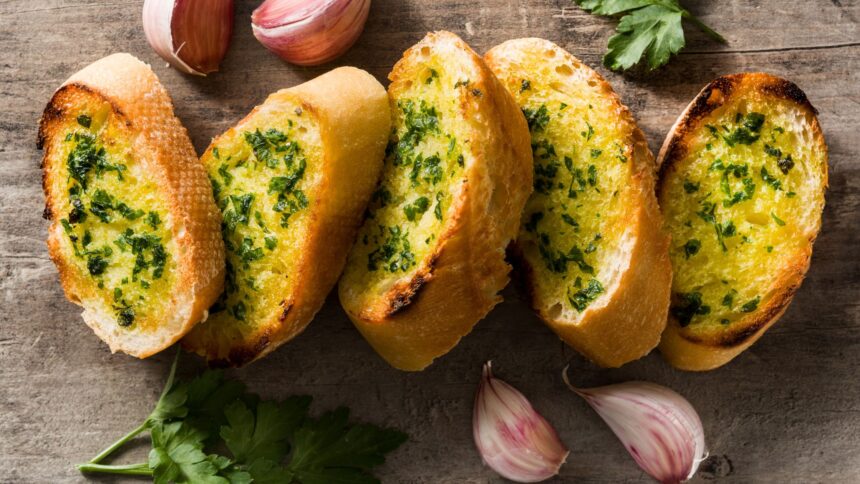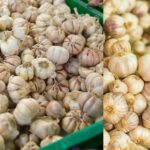Garlic bread is a beloved side dish that complements a variety of meals, from pasta to soups to salads. Often, garlic bread is made using specialty bread like ciabatta or baguette. However, you might be surprised to learn that you can create delicious garlic bread using regular bread that you probably already have in your kitchen. This article will guide you on how to make garlic bread with regular bread, ensuring you can enjoy this tasty treat anytime without needing to rush to the store for specific ingredients.
Ingredients Needed
To make garlic bread with regular bread, you’ll need the following ingredients:
- Regular bread: This can be white, whole wheat, or any sandwich bread you prefer.
- Butter or margarine: Softened for easy spreading.
- Garlic: Fresh garlic cloves are preferred, but garlic powder can be used in a pinch.
- Parsley: Fresh parsley adds a burst of color and a subtle flavor, though dried parsley can be substituted.
- Salt: A pinch to enhance the flavors.
- Optional Cheese: Parmesan or mozzarella can be added for an extra indulgent touch.
Step-by-Step Instructions

1. Preheat Your Oven
Before you start preparing the garlic bread, preheat your oven to 375°F (190°C). This ensures that your oven is at the right temperature when you’re ready to bake the bread.
2. Prepare the Garlic Butter
Using Fresh Garlic:
- Mince the Garlic: Take 2-3 garlic cloves, peel them, and mince finely. You can also use a garlic press for convenience.
- Mix with Butter: In a small bowl, combine the minced garlic with about half a cup of softened butter or margarine. Mix well until the garlic is evenly distributed.
Using Garlic Powder:
- Combine with Butter: If using garlic powder, mix about 1-2 teaspoons of garlic powder with the softened butter.
3. Add Parsley and Salt
- Chop Parsley: Finely chop a handful of fresh parsley.
- Combine: Add the chopped parsley to the garlic butter mixture along with a pinch of salt. Stir until everything is well combined.
4. Prepare the Bread
- Slice the Bread: If your regular bread isn’t pre-sliced, slice it into approximately 1-inch thick pieces. If you prefer thinner or thicker slices, adjust accordingly.
- Spread the Mixture: Spread the garlic butter mixture generously on one side of each bread slice.
5. Baking the Bread
- Arrange on Baking Sheet: Place the buttered bread slices on a baking sheet, buttered side up.
- Bake: Put the baking sheet in the preheated oven and bake for about 10-15 minutes or until the edges of the bread turn golden brown and crispy.
6. Optional Cheese Addition
If you want to add cheese, sprinkle grated Parmesan or mozzarella on top of the bread slices during the last 5 minutes of baking. This will allow the cheese to melt and become bubbly and golden.
7. Serve
Once baked, remove the garlic bread from the oven and let it cool slightly. Serve warm alongside your favorite dishes.
Tips and Variations
Using Different Types of Regular Bread
While white or whole wheat sandwich bread is common, you can experiment with other types of regular bread:
- Multigrain Bread: Adds a hearty texture and flavor.
- Sourdough Bread: Offers a tangy twist to your garlic bread.
- Rye Bread: For a distinct, robust flavor.
Adding Extra Flavors
- Herbs: Besides parsley, consider adding other herbs like oregano, basil, or thyme.
- Spices: A pinch of red pepper flakes can add a bit of heat.
- Lemon Zest: For a fresh, zesty flavor, add a bit of lemon zest to the garlic butter mixture.
Making It Vegan
- Butter Substitute: Use a vegan butter substitute or olive oil instead of regular butter.
- Cheese Substitute: Opt for vegan cheese if you want a cheesy garlic bread.
Stovetop Method
If you don’t want to use the oven, you can make garlic bread on the stovetop:
- Heat a non-stick skillet over medium heat.
- Place the buttered bread slices, buttered side down, in the skillet.
- Cook until the bread is golden and crispy, about 2-3 minutes on each side.
Air Fryer Method
For a quicker method, use an air fryer:
- Preheat the air fryer to 350°F (175°C).
- Place the buttered bread slices in the air fryer basket.
- Air fry for about 5-7 minutes or until golden brown.
Why Use Regular Bread?
Using regular bread for garlic bread has several advantages:
- Convenience: Regular bread is something most people have on hand, making it easy to whip up garlic bread without a special trip to the store.
- Versatility: Regular bread comes in many varieties, such as white, whole wheat, multigrain, and more, allowing you to customize your garlic bread to suit your taste preferences.
- Cost-Effective: Specialty breads can be more expensive. Using regular bread is a budget-friendly option that doesn’t compromise on flavor.
Nutritional Information
Garlic bread made with regular bread can vary in nutritional content based on the ingredients used. Here’s a general idea of what you might expect per slice:
- Calories: Approximately 150-200 calories.
- Fat: Around 10-12 grams, depending on the amount of butter or margarine used.
- Carbohydrates: About 15-20 grams.
- Protein: Approximately 2-4 grams.
- Fiber: Varies depending on the type of bread used; whole grain bread will have more fiber.
- Vitamins and Minerals: Garlic and parsley provide vitamins A and C, along with antioxidants.
Healthier Alternatives
If you’re looking to make your garlic bread a bit healthier, consider these modifications:
- Whole Wheat Bread: Opt for whole wheat or multigrain bread to increase fiber and nutrient content.
- Reduced-Fat Butter: Use a reduced-fat or light butter to cut down on calories and fat.
- Olive Oil: Substitute butter with olive oil for a healthier fat option.
- Less Salt: Reduce the salt or use a salt substitute.
Pairing Garlic Bread with Meals
Garlic bread is incredibly versatile and can be paired with a variety of dishes:
Pasta
Garlic bread is a classic accompaniment to pasta dishes. It pairs well with:
- Spaghetti Bolognese
- Fettuccine Alfredo
- Lasagna
- Pasta Primavera
Soups
Serve garlic bread with hearty soups such as:
- Tomato Basil Soup
- Minestrone
- Chicken Noodle Soup
- Lentil Soup
Salads
Add a slice of garlic bread to your salad for a satisfying crunch:
- Caesar Salad
- Greek Salad
- Caprese Salad
- Garden Salad
Main Courses
Garlic bread can also complement main dishes like:
- Grilled Chicken
- Steak
- Seafood
- Roasted Vegetables
Storing and Reheating Garlic Bread
If you have leftover garlic bread, you can store it and reheat it later.
Storing
- Refrigerator: Wrap the garlic bread in aluminum foil or place it in an airtight container. It will keep in the refrigerator for up to 3-4 days.
- Freezer: For longer storage, wrap the garlic bread in plastic wrap and then aluminum foil, or place it in a freezer-safe bag. It can be frozen for up to 3 months.
Reheating
- Oven: Preheat your oven to 350°F (175°C). Place the garlic bread on a baking sheet and heat for 10-15 minutes or until warmed through.
- Microwave: Wrap the garlic bread in a damp paper towel and microwave for about 20-30 seconds. Note that this method might not keep the bread as crispy.
- Air Fryer: Reheat in the air fryer at 350°F (175°C) for about 3-5 minutes.
Conclusion
Making garlic bread with regular bread is an easy, convenient, and delicious way to enjoy this popular side dish. By following the steps outlined in this guide, you can create flavorful garlic bread that pairs perfectly with a variety of meals. Whether you’re using white, whole wheat, or another type of regular bread, the key is in the preparation of the garlic butter and the baking process. With a few simple ingredients and some creativity, you can elevate your regular bread into a savory, aromatic garlic bread that’s sure to impress. Enjoy your homemade garlic bread with your favorite dishes, or even as a standalone snack. Happy cooking!
FAQs:
Can I use pre-minced garlic from a jar instead of fresh garlic?
Yes, you can use pre-minced garlic from a jar as a substitute for fresh garlic. Pre-minced garlic is convenient and can save time. Generally, 1 teaspoon of pre-minced garlic is equivalent to one fresh garlic clove. However, the flavor might be slightly different, as pre-minced garlic can have a milder taste compared to fresh garlic.
What type of butter should I use?
You can use either salted or unsalted butter, depending on your taste preference. If you use salted butter, you might want to reduce the amount of additional salt you add to the garlic butter mixture. For a healthier alternative, you can use a light or reduced-fat butter. If you prefer a dairy-free option, margarine or a plant-based butter substitute works well too.
Can I make garlic bread without butter?
Absolutely! You can substitute butter with olive oil for a different but equally delicious flavor. Olive oil not only provides a rich taste but also has health benefits, such as healthy fats. Simply mix the minced garlic, parsley, and salt with olive oil and spread it on the bread slices.
How can I make the garlic butter spread more evenly?
To ensure the garlic butter spreads evenly, make sure your butter is softened to room temperature. If the butter is too hard, it will be difficult to spread and might tear the bread. You can also use a food processor to blend the butter, garlic, parsley, and salt together for a smoother, more uniform mixture.
Is it possible to make garlic bread in advance?
Yes, you can prepare garlic bread in advance. Assemble the bread with the garlic butter and then wrap it tightly in aluminum foil. Store it in the refrigerator for up to 24 hours before baking. If you need to store it longer, you can freeze the assembled garlic bread. When ready to bake, preheat the oven and bake directly from the refrigerator or freezer, adding a few extra minutes to the baking time if frozen.
Can I use garlic powder instead of fresh garlic?
Yes, garlic powder can be used as a substitute for fresh garlic. Use about 1-2 teaspoons of garlic powder mixed with the butter or oil. Keep in mind that garlic powder has a different flavor profile and might lack the pungency and texture of fresh garlic, but it still makes for delicious garlic bread.
How do I prevent the bread from getting too soggy?
To prevent garlic bread from becoming soggy, don’t over-apply the garlic butter mixture. Ensure a thin, even layer is spread on the bread. Also, make sure to bake the bread at a high enough temperature (375°F or 190°C) so it crisps up properly. If you’re adding cheese, do so in the last few minutes of baking to prevent the bread from getting too greasy and soggy.
What can I add to garlic bread to enhance the flavor?
You can enhance the flavor of garlic bread by adding a variety of ingredients. Some popular options include:
- Cheese: Sprinkle-grated Parmesan or mozzarella on top.
- Herbs: Add dried or fresh herbs like oregano, thyme, or basil.
- Spices: A pinch of red pepper flakes can add a kick of heat.
- Lemon Zest: A little lemon zest can add a fresh, zesty flavor.
How do I store and reheat leftover garlic bread?
To store leftover garlic bread, wrap it in aluminum foil or place it in an airtight container. It can be stored in the refrigerator for up to 3-4 days or frozen for up to 3 months. To reheat, preheat your oven to 350°F (175°C) and bake the bread for 10-15 minutes until warmed through. For a quicker option, you can microwave it wrapped in a damp paper towel for 20-30 seconds, though it may not be as crispy.
Can I make garlic bread using gluten-free bread?
Yes, you can make garlic bread using gluten-free bread. Simply follow the same steps outlined for regular bread. Gluten-free bread might have a different texture and flavor, but it works perfectly well for garlic bread. Be sure to check that all your ingredients, including butter and any add-ins, are also gluten-free if you have dietary restrictions.




